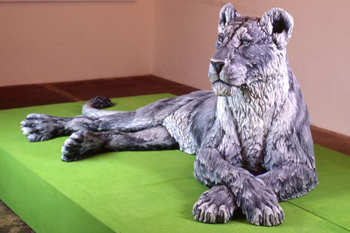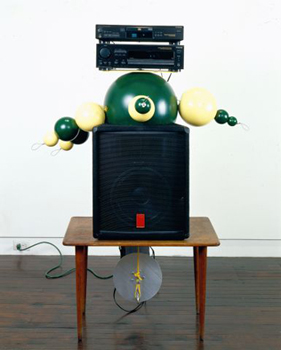To hit the street on a Saturday in Los Angeles with Dean Valentine, collector extraordinaire, is no small thing. I had the memory of one afternoon with him in mind while exploring his recent gift of sculpture to the Hammer Museum in its inaugural exhibition Second Nature, which continues through October 4th.

Lioness by Ruby Neri, Photo Credit: Joshua White
Shadowing him a few years ago in and out of a series of galleries, I tried to pick up some pointers. He would nod or say a quick hello at the reception desk, not stopping though, eager to get at the art -- catching up with someone's work he already knew, or getting a fix on a new artist. He would take a beat as he entered the main gallery space, almost as if he was getting the scent.
Usually, the gallerist would quietly make his or her way over to Valentine (he would be immediately recognized but given the space to absorb things at his own pace), ready to answer a few questions or just add a few biographical details to the artist's latest work. He is open and accessible, always ready to discuss.
Valentine is impressive in many ways, not least of all because he is utterly fearless and, like a truly great collector, he does not look over his shoulder. He has a discerning, demanding eye but also an enormous humanity. It is a blessed combination for the artists whose work he acquires -- pieces that speaks to his mind, his funny bone or his heart.
It turns out what he likes and what the contemporary art market likes are often the same thing. Is this because he is leading the pack? Possibly. I prefer to think it's because he asks the hard questions and is really channeling something on behalf of the rest of us, the medium by which we are getting the message.

Swan Cycle by Pentti Monkkonen, Photo Credit: Joshua White
Valentine took some time to be thoughtful about today's art world and his place in it.
Culture Zohn: You have been seriously collecting for the decade I've known you -- not just sculpture but painting as well. How is it that you are so fearless about knowing what you like?
Dean Valentine: It isn't hard being fearless. What's hard is knowing what I like. I've found over and over that when the liking comes too easily, the art usually isn't very good. Its the stuff that gives you a hard time, that makes you look twice, that maybe repels you or puzzles you at first, that's usually where my collecting begins. You have to learn to not trust yourself.
CZ: The market has validated many of your choices, or perhaps it's following your good instincts. How much does it matter that so much of your collection is now in the stratosphere?
DV: Validation by the market or others is always nice, no matter what anyone tells you. But I've never bought a work because I thought it would make money. In fact money is never ever a factor because it leads to bad artistic decisions (unless its the issue of whether I can actually afford something).
CZ: What about the contemporary art scene in Los Angeles? How has the recession affected what is going on? Is it any different in New York? Are the artists in this show in danger of having to wait tables or does the waning of the art market give them needed time to pull back from being as overtly commercial?
DV: For the last 30 years Los Angeles has been the world capital for contemporary art -- not for galleries, or museum or collectors. But it's where the best artists have been making the best and most important work. Again and again the art that is made here gets validated by the rest of the globe -- sometimes it takes a few years, but it always happens -- from the early days of Conceptual Art in the late 60s -- Ed Ruscha, Al Ruppersberg, John Baldessari, Bas Jan Ader, Bruce Nauman, through Mike Kelley and Charlie Ray, all the way to artists like Richard Hawkins, Stephen Rhodes, Nate Hylden, Paul Sietsema, and Sterling Ruby today.
The recession always affects gallerists and collectors, of course. A few galleries have or will shut down. Fewer kids will go to art school Some will indeed have to take on other jobs. But artists make art because they have to, because that's the only way they can live. That never changes, no matter what the economy. LA, which has never had the infrastructure of galleries and collectors that New York does, is less affected. There's a lot more damage in New York.
CZ: What is it about UCLA? The professors there seem uncommonly supportive of their students, many of whom are represented in this show. Does an advanced degree really matter for an artist in 2009?
DV: Its not just UCLA. Its Art Center and Cal Arts and Claremont and Otis and USC. Each of them has amazing artists who also teach. It's about that, that an entire generation of amazing artists were hired by these universities to teach. That hasn't happened in New York very much. Do you really need an academic degree? No, not really. But it sure helps. Think of it as similar to the apprentice system of three or four hundred years ago. An artist has to learn from someone, and what better someone than another great artist?
CZ: Your wife has traditionally left most of the heavy art lifting to you. Does the gift to the Hammer represent the beginning of deaccessioning to make way for the new, or are you onto the Next Big Thing?
DV: It feels great to give things away. But it will never replace the fun of finding and buying it in the first place, much to my wife's (supportive) chagrin.
A few years ago, Annie Philbin snared Valentine for her board at the Hammer Museum where she is director; she has stimulated its transition from being one oil man's plaything to a serious and important reason to come to Los Angeles. Philbin wanted the Hammer to be not only a must-see venue for the public, but also a place for artists to have a chance to be inspired themselves.
Valentine has given the Hammer a core group of 50 sculptures by LA artists, and his open and yet slightly twisted sense of humor is well reflected in this smart and engaging work. It feels vaguely post-Pop, most medium-to-large in scale, sometimes kinetic, sometimes musical, sometimes with video elements, sometimes three dimensional and fixed.
 >
>
Philbin hopes the Valentine-Adelson collection (Valentine has given wife Amy Adelson titular recognition but she freely admits she had seen little of it before the work went on display. Valentine's art appetite and the physical limitations of their modest home are not always in perfect synchronicity -- most of his collection is in storage or on loan at various times) will be a cornerstone of her effort to collect contemporary art for the Hammer.
Curators Douglas Fogle and Ali Subotnick have supervised a compelling installation, just the right size for understanding something of Valentine's clever collecting energy.